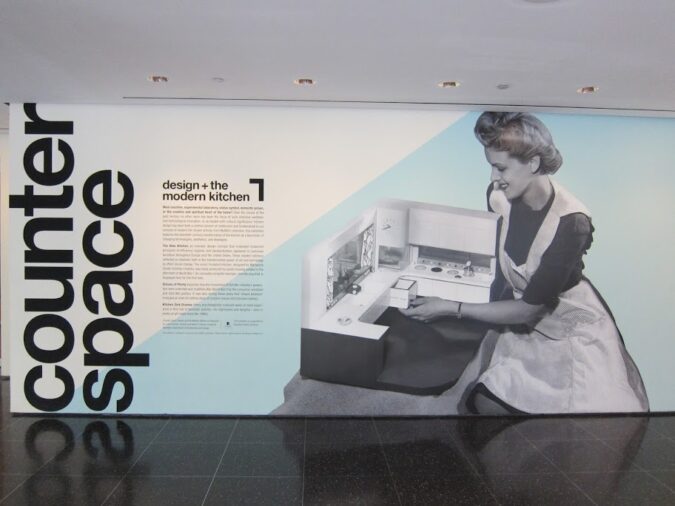
I was thrilled to get the chance to go to an exhibit on the Frankfurter Kitchen and modern kitchen design at MoMA in New York recently. The exhibit was called “Counter Space” – here’s a link to the exhibit website.
Back in the day (more specifically, from 1999 to 2001) I wrote my master’s thesis on the debate over “the scientific kitchen” in Norway, 1900-1940, and the Frankfurter kitchen was a huge influence on this discussion (the thesis is available in fulltext here). I looked at how many well-to-do women who had previously had a maid increasingly needed to take over the housework themselves at the beginning of the 1900s. Being a maid was hard work, and many young women chose to instead seek work in the rapidly growing small-scale industry in Norway. Good maids suddenly were hard to come by. As a result, the modern Norwegian housewife came into being. They sought to not only make housework easier, but also to increase the status of the work in the home. The home was a workplace like any other. Nowhere was that more obvious than in the kitchen.

The international home economics movement attempted to improve the kitchen and make the work that took place there more rational. Margarete Schütte-Lihotsky designed a kitchen based on the ideals laid out by Christine Frederick and the home economics movement in the 1920s. The kitchen was intended to be affordable, efficient, and suitable for mass production.

The Frankfurt kitchen has become an iconic representation of the modern kitchen as laboratory. Inspired by ideas of efficiency and scientific management (also known as Taylorism), this kitchen is a great example of how knowledge and technologies circulate between producers and consumers, between factories and the home. The women who worked to promote scientific homekeeping had great hopes for the kitchen as a liberating space for women, a place where women could become part of modern society.
Some of the same ideals underpinned the famous Nixon-Khrushchev (sp.) kitchen debate in 1959, a recurring topic in a recent (and quite good) book on Cold War kitchens that I reviewed for Technology and Culture last year. In this TV-broadcast meeting of the two head-of-states, the high-tech kitchen on display in the American National Exhibition in Moscow came to represent the virtues of American technology.
It was a kitchen made at a time with a strong optimism and belief in science and technology. We can see some of the same story at work in the fantastic Norwegian movie, “Kitchen Stories,” from 2003. The trailer above (and the movie itself) is definitely worth seeing.
However, the result of all this activity in the kitchen between 1900 and 1960 is far from clear-cut. Yes, the kitchen is far more advanced and far more ergonomic, but as Ruth Schwarz Cowan’s classic study in history of technology shows, changing expectations of what a home should be actually made “more work for mother.”
All in all, the MoMA exhibit gave a very fascinating insight into this particular moment in time, where modern science and technology promised to transform the home. As a historian of technology, I enjoyed seeing the physical artifacts themselves, rather than just pictures reproduced in a book. I love teaching classes about the changing kitchen of the 20th century, and I definitely have some new material for this now.
All photos in this post by Finn Arne Jørgensen, released under a CC-BY License.